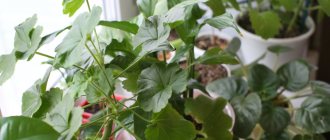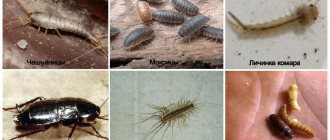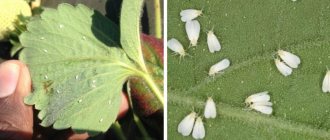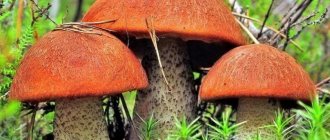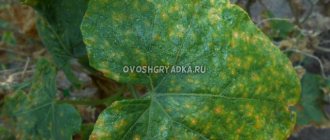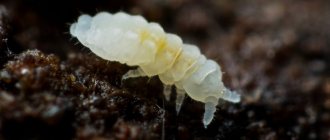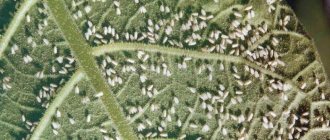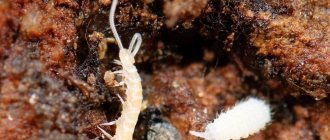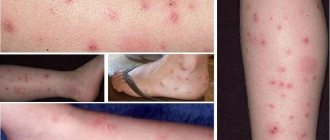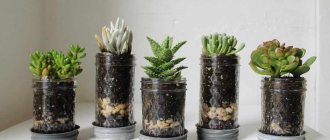All plants, no matter where they are grown, are subject to invasion by various pests. In addition, indoor plants that housewives love to grow are susceptible to various diseases and the harmful effects of various insects. Various reasons contribute to this. Often housewives themselves are to blame for this, since they do not create the proper conditions for growth and development for plants. Some of them simply forget to water the plants, and some of them water them excessively. It should be noted that there are quite dangerous pests that can reduce a person’s work to zero.
As a result of the appearance of pests, indoor plants lag behind in development and lose their attractiveness, and often even die. Therefore, the main task of indoor plant lovers is the timely detection of parasites and subsequent control of them. This article talks about the main pests of indoor plants, their appearance, as well as ways to combat them.
Whitefly
This is an insect with a body length of no more than 2 mm. A characteristic feature is white wings and a yellowish body. They can be found:
- On the back side of the leaves, where they are located in colonies.
- According to characteristic sweetish traces, on which after some time a sooty fungus appears.
Whitefly larvae have a sucking type of mouthparts, so they suck out the juices from the plant. As a result, the plant loses its vitality and gradually loses its attractiveness. If no measures are taken, the plant will soon die.
Interesting fact! When appearing in greenhouses, the whitefly prefers plants such as hibiscus, pelargonium or begonia. After the appearance of just one individual, after a short period of time a whole colony of these insatiable pests appears in the greenhouse. In this regard, the fight should begin immediately.
Saving indoor plants from pests and diseases - Everything will be fine - Issue 282 - 11/05/2013
Prevention
If there are bedbugs in neighboring apartments, it is necessary to carry out preventive treatment of the entire house with insecticidal preparations:
- For the purpose of preventive measures, you need to carefully inspect all brought furniture. Especially if the furniture was purchased secondhand. It is also recommended to inspect wardrobe items, bags and suitcases. This can keep you away from nasty pests.
- You should not bring home discarded soft toys, which are often the site of large concentrations of bedbugs.
- If you have returned from a trip where you stayed at a hotel, then the first thing you need to do is inspect your travel bag or suitcase and, in case of the slightest suspicion of the presence of “guests,” carry out thermal or chemical treatment of it.
Aphid
These are also harmful insects that suck juices from plants due to the presence of piercing-sucking mouthparts. Insects have an ovoid body shape, no more than 2 mm in length. Aphids have rather long legs, but they move rather slowly. The color of insects depends on the species, as well as on living conditions, so it can be varied.
There are both winged and wingless types of insects. Naturally, insects with wings can easily enter a person’s home, even through an open window.
We recognize pests
First of all, you need to pay special attention to whether your plants have any pests, since they are the ones that can spoil the condition of potted flowers and sometimes even kill them.
The most common are small white bugs that spread very quickly throughout the flower. Before we talk about how to get rid of such “unexpected guests”, it is necessary to find out the reasons why small white insects appeared in the pot.
We tried to find out what factors contribute to their appearance:
- it is likely that small white insects in flower pots were blown onto the plants by the wind, by way of an open apartment window. Therefore, it is better not to place plants under direct wind flows from the street;
- Also, if you notice that strange white small insects have appeared in the soil of your flowers, photos of which on the Internet are labeled with various names - from aphids to thrips, the soil itself could be the reason for the appearance. Midge larvae could be brought in with soil, especially if it was not purchased in a specialized store, but was taken from the forest or garden;
- If there are small jumping midges in the pot, the reason for their spread could be waterlogging of the soil or the process of rotting caused by excessive watering of the plant.
Having found out the reasons for the appearance, we figured out how to prevent small white insects from appearing in the apartment. However, if such unexpected guests do appear, you need to be able to detect the problem at the first signs.
Hairy aphid
This type of aphid is also called mealybugs. They are one of the most dangerous insects for plants. As a rule, they can be found on the underside of leaves. Their presence is indicated by a cobweb-like white coating, as well as the presence of a sticky liquid.
These insects are distinguished by a high degree of fertility. Female mealybugs lay eggs in miniature formations that resemble balls of cotton wool. After a certain time, fairly mobile larvae emerge from these lumps, which are then distributed throughout the plant. Fighting them requires an instant reaction. The sooner you start fighting this pest, the greater the chance of saving the plant.
Mealybug is a pest of domestic flowers. Signs of infection, methods of control
How to get rid of white bugs in the soil of indoor plants
Professional preparations and folk remedies are used to control pests. The choice depends on the individual preferences of the grower and the number of parasites.
- Aktara. Universal insecto-acaricidal agent. Destroys adult individuals, imago. White bugs die within 30 minutes. The product continues to act for another 20 days, preventing re-infection. Does not harm the plant, helps to recover. 4 g of the drug is enough for 5 liters of cold water. Spraying is carried out in a well-ventilated area or outside.
- Actellik. Broad-spectrum insecticide. Destroys pests in 20 minutes and continues to work for another 20 days. Sold in ampoules of 2 ml, designed for 5 liters of water. The solution is prepared immediately before use. Plants are sprayed outdoors. The drug is toxic and requires strict adherence to the instructions.
- Inta-Vir. An insecticidal preparation for treating any plants in open or closed ground. The tablet dissolves in 10 liters of water. Spray the flowers in a well-ventilated area. Does not affect vegetation, helps restore strength.
Preparations against pests
If bugs appear in indoor flowers, you need to reconsider the care conditions. Pests reproduce in high humidity or do not tolerate water. Initially, you should understand the type of parasite, then take action. Sometimes it is enough to simply dry the soil or spray the flower with cold water to make the parasites disappear.
- Soap. If there are white bugs in a flower pot, the plant is sprayed with a concentrated soap solution. Use laundry, tar, and green soap. Repeat the procedure after 2 days. Pests disappear completely within 14 days.
- Manganese. Dissolve potassium permanganate in water until it turns pink and water the soil. A powerful antibacterial agent will destroy all small parasites. The same action must be performed when replanting plants to disinfest the soil.
- Orange zest. Cut off the peel, pour alcohol, leave for a day. Spray the soil and plant. If you don’t have time to prepare a folk remedy from orange, you can use vodka.
To prevent the appearance of white bugs, it is necessary to use special soil, disinfect the soil, follow watering rules, and place a mosquito net on the windows.
All plants, no matter where they are grown, are subject to invasion by various pests. In addition, indoor plants that housewives love to grow are susceptible to various diseases and the harmful effects of various insects. Various reasons contribute to this. Often housewives themselves are to blame for this, since they do not create the proper conditions for growth and development for plants. Some of them simply forget to water the plants, and some of them water them excessively. It should be noted that there are quite dangerous pests that can reduce a person’s work to zero.
As a result of the appearance of pests, indoor plants lag behind in development and lose their attractiveness, and often even die. Therefore, the main task of indoor plant lovers is the timely detection of parasites and subsequent control of them. This article talks about the main pests of indoor plants, their appearance, as well as ways to combat them.
Root mealybug
This type of pest poses the main threat to the root system of plants. The parasite can be detected either in the ground or on the lower part of the plant stems, by a whitish coating. Females reach a length of up to 2.5 mm, while they are larger than males and much more mobile. Pests are distinguished by their almost cylindrical body shape, covered with a waxy coating. Females lay eggs in special chambers formed by special secretions.
Males are more like whiteflies. As adults, they quickly die because they stop feeding. Therefore, females make up the main population of these pest colonies.
It is important to know! The presence of such insects on indoor plants leads to the fact that the plants lose their attractive appearance. In addition, damaged plants begin to suffer from fungal diseases.
Does it bite?
Like all representatives of the order of bedbugs, the White bug also feeds on the blood of warm-blooded animals and, in some situations, is capable of feeding on human blood. The appearance of this parasite in the house is very difficult not to notice, but there is a high probability of confusing bedbug bites with the bites of other pests. In the morning you will find red dots on your body that are quite itchy and may later become swollen and even inflamed. In the center of the red spot you can see a black dot - this is the mark of an injection made by the bug with its proboscis. In general, bites are usually multiple and can most often be found on the neck, back, shoulders, arms and legs. The bites are located in the form of tracks at a distance of 2-5 centimeters from each other. Red spots can range from several to several dozen. After some time, the itching goes away and the bite marks disappear. However, if a person is allergic to insects, these bites can cause very disastrous consequences.
It is possible and necessary to quickly relieve unpleasant sensations. To do this, you need to apply ice or something cold at hand to the bite site. And after that, be sure to lubricate the wound with an alcohol-containing solution (calendula tincture, ethyl alcohol, etc.). This treatment will prevent infection from entering the wound and help avoid negative consequences.
REFERENCE! If the wound becomes inflamed, it can be lubricated with anti-inflammatory ointments, which are available to everyone, as they can be found in any pharmacy.
Shchitovka
Scale insects also appear on house plants, and each type of scale insect can infect a specific type of plant. The palm scale insect parasitizes the shoots of palm trees. There are also cactus, pink, ivy, Californian, laurel, and oleander scale insects. Often scale insects appear on lemons or orchids. A characteristic feature of these pests is the shell that protects their body. In this regard, it is quite difficult to fight scale insects.
The false scale insect, which does not have a waxy shell, poses a huge danger to plants. The females of these pests grow up to 5 mm in length, and they have neither legs nor wings, unlike males. Females are distinguished by the fact that their body is covered with a convex shield, which can have different shapes, both round and oval.
These parasites prefer to be found on any part of the plant, both on the stems and on the back of the leaves. There is also a hemispherical scale insect, which is slightly larger in size and volume. Plants such as ferns, asparagus and myrtle are affected by these pests. Below is the appearance of some pests of indoor plants.
Fighting scale insects (pests of indoor plants). Part 1
Types of insects
In order for your pest control to be as effective as possible, you need to determine what kind of midge is in front of you. Maybe a moth? Or thrips? In order to answer this question, we will talk about the most common types:
- aphids - small insects in the bathroom, yellowish-greenish in color, oblong in shape;
- whitefly - white insects in the soil of indoor plants, resembling butterflies no more than 3 mm;
- Podura springtails are a lichen-eating pest, a small white insect with long antennae.
If such midges are destructive to plants, the logical question is whether they can cause harm to humans. As far as we know today, insects that live on flowers are quite unpleasant, but they are not capable of harming human life and health, since they are destructive exclusively to plants. Therefore, do not panic if you notice such “living creatures” on orchids or any other flowers.
Ways to fight
The most popular methods of combating small white insects that have appeared in the ground are presented in the photo. If you have noticed any pot pests, you need to know how you can quickly and easily get rid of them. After reading the descriptions of these three products, you will no longer wonder what to do and how to get rid of white insects in the bathroom.
The advantage of this product is that it is easy to spray and does not emit a persistent unpleasant odor when used. However, its effectiveness remains in question, since according to user reviews, plants have to be processed several times.
Aktara is good because it does not cause any harm to plants, carefully gets rid of insects, and also does not disturb the condition of the earth. The downside is that some especially tenacious individuals are able to stay and breed again.
Fitoverm is a powerful remedy against pests that will not leave them any chance of survival. However, it is difficult to find it in the store, since the product is quite rare, and it is also worth considering that it is not suitable for all types of plants.
Means for controlling midges
In a situation where you do not trust store-bought products and doubt their effectiveness in combating small black insects that have appeared on indoor plants, home remedies will be a real salvation. They are also useful when you are concerned about the health of your flowers.
1. Orange with alcohol.
What you will need:
- orange;
- alcohol;
- container with a spray bottle.
- Peel the oranges.
- Pour alcohol into the container.
- Cut the orange zest into small pieces and add to the container.
- Leave for 2 weeks, then spray the soil around the plants.
After completing this operation, you can be sure that pests no longer live on the flower.
2. Water with potassium permanganate.
What you will need:
- Warm up the water.
- Add potassium permanganate crystals until a rich purple color is obtained.
- Water the soil and spray the leaves of the plants.
This product is effective for small insects of any name that may live in your apartment, and photos of which you can see below.
3. Tar soap.
What you will need:
- Heat the water until warm.
- Carefully dissolve the soap.
- Sprinkle the soil with this solution.
This method is quite simple, much simpler than those you could see earlier in the video, however, it is quite effective.
Purchasing drugs
If you are faced with this problem and trust only industrial products, below are the addresses of stores where you can purchase the drug Aktara in Moscow, St. Petersburg, Yekaterinburg, Chelyabinsk, Minsk and Kyiv:
| Name | Address | Cost, rub |
| Gazonov | Moscow, st. Dubninskaya, 75A, building 7, office 9 | 104 |
| Obi | Saint Petersburg | 110 |
| Magazine-naturalist | Ekaterinburg, st. Mashinostroiteley, 14 | 127 |
| Leroymerlin | Chelyabinsk | 114 |
| Minsk | Minsk | 105 |
| Agro-store | Kyiv | 112 |
Insects in dreams
Often, the appearance of certain symbols in a dream can tell some secrets about a person and his future. Often, certain images can be imprinted in a child’s head, which are reflected in a dream - midges are a frequent occurrence. Today we will find out how to understand that you dreamed of insects:
- According to Longo’s dream book, seeing insects speaks of a person’s preoccupation with minor problems.
- Maneghetti's dream book has a positive attitude towards the image of insects and interprets it as an opportunity for our own analysis.
- If you dreamed of an insect, this may also be a sign of illness according to the symbolic dream book, so you should pay special attention to your state of health.
White fool
White podurs are hopping insects that can be found in potted houseplants. They differ:
- An elongated body on which sparse hairs grow.
- Having 3 pairs of legs.
- Having a long mustache.
- Prefers moist conditions.
The diet of these pests includes the remains of plant components, as well as a living root system. If you do not pay attention to these parasites in time and do not destroy them, they can lead to the death of indoor plants.
Chemicals to the rescue
If it is not possible to mechanically remove the larvae and adult insects that have settled in the roots of the plant (planting in deep tubs), use insecticides: Tanrek, Kinmiks, Agravertin, Fitoverm, Aktaru, Konfidor. The solution is prepared in the following proportion: 8 g of the drug per bucket of water. If Intavir is used, then 1 tablet of the product is pre-diluted in 10 liters of water.
The product has been tested many times against indoor pests
Podura in flowers feel very confident, so the plant needs to be watered twice every 7 days with an insecticide solution at the rate of 100 ml of the drug per 0.7 liter pot.
Attention! Insecticides should be applied to the soil to soak it, rather than used for irrigation purposes. Larvae and mature insects live under the top layer of soil.
Fine-grained sand can be used. It is washed well and dried. The top thin layer of soil (several centimeters) is removed from the pot. The remaining soil is watered with any insecticide against the Colorado potato beetle. A thin layer of sand is scattered on top. Apply granulated Grom-2 or Bazudin, scattering the preparations in small quantities onto a slightly damp soil surface. A thin layer of soil is laid on top and watered abundantly. For greater effectiveness, do not water flowers in pots for 5 days after treatment.
Spider mite
Many indoor plant lovers are familiar with this common and quite dangerous pest. This is a tiny insect that can only be detected with a magnifying glass. Colonies of these insects are found on the underside of leaves. Spider mites prefer warm and dry air. Under such conditions, the insect reproduces at a tremendous rate.
You can determine that a plant is infected with spider mites:
- By light spots that are visible in places where pests live.
- By the presence of the finest cobwebs that cover plants.
Chinese roses, geraniums and palm trees suffer quite a lot from the invasion of spider mites, which suck the juices out of them.
Thrips
These are insects whose length does not exceed 1.5 mm. Pests can be identified by their black or dark brown body color, with the lower part of the body being a reddish-yellow hue. Like most pests, thrips hide on the underside of leaves. The female lays eggs in very small holes, which she gnaws in the leaves and also in flower buds.
It is important to know! The appearance of a silver pattern on indoor plants indicates that the plants are infected with thrips. These are traces of their life activity.
TRIPS on indoor flowers | PESTS of indoor plants and their control
What do people advise?
- An infusion of tobacco dust, shag, and red hot pepper is used as a watering solution. Infuse a pound of tobacco waste or shag in 10 liters of water for 48 hours. Add soap shavings (40g) to the strained mixture. The plant itself is sprayed with the finished product and the soil is watered.
- You can also cultivate the soil with a weak solution of potassium permanganate.
- Dry celandine is used. 1 kg of raw materials is poured and infused in water (10 l). The infusion, aged for 24 hours, is filtered. They cultivate the soil.
Radical means of control will not be needed if plant nutrition and watering regime are properly organized and a healthy indoor microclimate is created.
| Rating: +3 |
| osya0412 |
Fungus gnats (sciarids)
These insects are also called scyriads. These are not large flies, up to half a centimeter long, that fly around indoor plants. Sexually mature individuals carry the larvae of various pests, which infect plants. The scyriads themselves lay eggs in the root system of plants, which causes great harm to the plants, since white larvae emerge from the eggs and feed on the root system. The result of their vital activity is dead indoor plants.
Control measures
How to get rid of pests? This question haunts many indoor plant lovers. Pest control can be done in a variety of ways. For example:
- Mechanical.
- With the help of biological drugs.
- Using chemical control agents.
- Based on folk recipes.
Pests of indoor plants and their control, plant protection, how to get rid of them
Mechanical method
This is an environmentally friendly, simple and affordable way to combat parasites on your own. To do this, you need to take a tool, preferably disinfected, and cut off the damaged parts of the plants. It is better to treat the cut areas with activated carbon. Pests that can be seen with the naked eye can be picked out with your hands without any problems, unless there are so many plants and pests.
Interesting recipe! A contrast shower will help rid indoor plants of parasites. It is enough to spray the flower with water and then wipe the leaves with a cotton swab and the problem can be solved.
Folk remedies
To protect them from various insects, as well as in cases of their diseases, many lovers of indoor plants prefer folk remedies. These products have been tested for many decades, so there is no doubt about their effectiveness. Decoctions prepared from plants such as chamomile, nettle, yarrow, dandelion or marigold are absolutely harmless to humans and plants. Solutions prepared with garlic and onions have the same effect. The prepared solutions are simply sprayed on the plants almost every day.
As an option, you can use citrus peels, which should simply be buried in the ground. The smell of these components cannot be tolerated by many parasites that want to settle on indoor plants.
Solutions based on wood ash, furatsillin, soda or potassium permanganate work no less effectively in this direction. You just need to prepare the solution correctly, after which the plants are sprayed with a spray bottle.
It is important to know! If you add a little soap, preferably laundry soap, to the solutions, the product will not drain from the leaves so quickly, which will enhance the effect of using the product.
Biological method
Biological preparations differ in that they act only on certain types of pests and are safe for humans and pets. Despite this, the working composition must be prepared correctly and used correctly. For example:
- The solution is prepared strictly according to the instructions.
- After treatment, the plant should dry.
- The room needs to be well ventilated.
For such purposes, you can use control agents such as Agrovertin, Fitoverm or Iskra-Bio.
No chemical attacks
Having discovered small populations of insects, you can do without the use of chemical reagents.
Orchid roots need to be carefully examined
- When a springtail is first detected, completely immerse the entire flower along with the pot in water. The floating insects are immediately collected. The plant should not be watered. The top layer of soil (up to 40 mm thick) is removed, and clean, dry sand is poured in its place.
- If podura pests are found in a flowerpot with orchids, the plant is removed from the bark and the roots are washed well with water. The processed rhizome is planted in the whole bark. The rot is cut off and the sections are dried.
- You can dissolve 0.5 tablets of citramone (ascophen) from your home medicine cabinet in 3 liters of water. When watering flowers, use this solution.
- Place the cut potato (cut side down) into the container with the flower. After a while, remove the vegetable along with the podurs that have penetrated into it.
- Dry lemon and orange skins and place them in pots with plants. Insects cannot stand the smell of citrus fruits and “leave.”
- Do not water the soil with a solution containing decomposing organic matter: milk, tea or coffee, etc.
- The soil and green areas are dusted with wood ash. Crushed into powder, it is sprinkled on the soil with a layer of 10 mm with scanty watering.
- Dry mustard is also used for dusting. Powder is sprinkled on the soil in a pot with a layer thickness of 10 mm with limited watering.
- Water with a solution: 40 g of grated laundry soap, pour 1 liter of water and dissolve.
- Dry mustard (10 g) is silted with water (1 l) at a temperature of 60°C. The solution is infused for 48 hours, after which it is filtered. Used for treating flower seeds before planting.
- The same mustard (1 tsp) is diluted in 1 liter of water. This is how the composition is prepared for watering and simultaneously destroying other pests.
